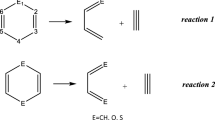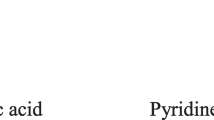Abstract
The electronic structures, intramolecular proton transfers, and rotational barriers around C–N, O–H, and N–H bonds in the biuret isomers have been investigated at B3LYP/6-311+G(2d,p) level of theory. The results showed that biuret is nearly planar and the diketo form 1 involving hydrogen in the central nitrogen N6 and in a trans-conformation of amino group and carbonyl group is the most stable isomer. Furthermore, in the next step, conversion of five most stable isomers to each other was also investigated. The results indicated that intramolecular proton-transfer step is the rate-determining step in all paths. Study of the relative stabilities and mechanism of conversion of isomers have been performed with polarizable continuum model, and it was found that with going to polar solvents the order of stabilities did not change. The heights of barrier for PT mechanism assisted by one-water molecule was also studied and calculated results showed that the water molecule assisting PT has much lower energy barrier than analogous barrier in the gas phase. Moreover, NBO calculation is carried out for tautomers to obtain donor–acceptor interactions.





Similar content being viewed by others
References
Craven B (1973) Perdeuterated biuret hydrate C2D5N3O2.(0.77D2O). Acta Crystallogr Sect B 29(7):1525–1528. doi:10.1107/S0567740873004851
Kurzer F (1956) Biuret and related compounds. Chem Rev 56(1):95–197
Birker PJMWL (1977) Stabilisation of high oxidation states by strong electron donors: the crystal structure of tetra-n-butylammonium o-phenylenebisbiuretatocuprate(III)-chloroform. J Chem Soc, Chem Commun 13:444–445
Birker PJMWL, Bour JJ, Steggerda JJ (1973) Spin-triplet cobalt complexes of biuret and related ligands. Inorg Chem 12(6):1254–1259
Malvi B, Panda C, Dhar BB, Gupta SS (2012) One pot glucose detection by [Fe III(biuret-amide)] immobilized on mesoporous silica nanoparticles: an efficient HRP mimic. Chem Commun 48(43):5289–5291
McLellan AW, Melson GA (1967) Transition-metal complexes of biuret and related ligands. Part I. Biuret complexes of some bivalent metal ions. J Chem Soc A 137–142
Mintcheva N, Mitewa M, Enchev V, Nishihara Y (2003) New stable complexes of Au(III) with biuret: X-ray structure of cis-[Au(Biu)Br 2]PPh4 and Ab initio investigation of cis-[Au(Biu)X2]. J Coord Chem 56(4):299–305
Löest CA, Titgemeyer EC, Drouillard JS, Lambert BD, Trater AM (2001) Urea and biuret as nonprotein nitrogen sources in cooked molasses blocks for steers fed prairie hay. Anim Feed Sci Technol 94(3–4):115–126
Xue J, Sands R, Clinton PW (2004) Effect of biuret on growth and nutrition of Douglas-fir (Pseudotsuga menziesii (Mirb) Franco) seedlings. For Ecol Manage 192(2–3):335–348. doi:10.1016/j.foreco.2004.01.042
Jones WW (1954) Biuret toxicity of urea foliage sprays on citrus. Science 120(3117):499–500. doi:10.1126/science.120.3117.499
Sahrawat KL (1977) Effect of biuret content on transformation of urea nitrogen in soil. Soil Biol Biochem 9(3):173–175
Xue JM, Clinton PW, Sands R, Payn TW, Skinner MF (2008) Fate of biuret 15N and its effect on net mineralisation of native soil N in forest soils. Aust J Soil Res 46(6–7):636–644
Felföldi N, Tóth M, Chrysina ED, Charavgi M-D, Alexacou K-M, Somsák L (2010) Synthesis of new glycosyl biuret and urea derivatives as potential glycoenzyme inhibitors. Carbohydr Res 345(2):208–213. doi:10.1016/j.carres.2009.10.016
Chromý V, Šváchová L, Novosád L, Jarkovský J, Sedlák P, Horák P, Dobrovolná H, Hlavácová B (2009) Albumin-based or albumin-linked calibrators cause a positive bias in serum proteins assayed by the biuret method. Clin Chem Lab Med 47(1):91–101
Schmidt EMDS, Paulillo AC, Dittrich RL, Hoppe EGL, Bertoli RS (2008) Determination of ring-necked pheasant (Phasianus colchicus) serum protein concentrations by refractometry and the biuret method. Int J Poult Sci 7(7):672–673
Guobing X, Lili J, Lihua Z, Tiean X (2001) Application of an improved biuret method to the determination of total protein in urine and cerebrospinal fluid without concentration step by use of hitachi 7170 auto-analyzer. J Clin Lab Anal 15(4):161–164
Aida K (1961) Infra-red absorption spectra of biuret and its metal complexes. J Inorg Nucl Chem 23(1–2):155–158
Geetharani K, Sathyanarayana DN (1976) Vibrational analysis and solid state conformation of monothiobiuret hydrate. Spectrochim Acta, Part A 32(2):227–232. doi:10.1016/0584-8539(76)80073-6
Ray A, Sathyanarayana DN (1975) Infrared and Raman spectra of 2,4-dithiobiuret and its normal vibrations. Spectrochim Acta, Part A 31(7):899–904. doi:10.1016/0584-8539(75)80153-X
Saito Y, Machida K, Uno T (1970) Infrared spectra of bis-biuret cadmium chloride, bis-biuret mercuric chloride and their deuterated compounds. Spectrochim Acta, Part A 26(10):2089–2097. doi:10.1016/0584-8539(70)80147-7
Suntsova MA, Marochkin II, Dorofeeva OV (2013) Structure and energetic properties of 1,5-dinitrobiuret. Struct Chem 24(3):745–750
Jabalameli A, Nowek A, Hart O, Sullivan R, Leszczynski J (1998) A post-Hartree-Fock quantum chemical investigation of biuret planarity. J Mol Struct (Thoechem) 425(1–2):161–170. doi:10.1016/S0166-1280(97)00213-3
Sullivan RH, Kwiatkowski JS, Leszczyński J, Jabalameli A (1993) Vibrational infrared spectra of biuret and its thioanalogs. An ab initio SCF/3-21G study. J Mol Struct 295:169–183. doi:10.1016/0022-2860(93)85018-P
Adane L, Bharatam PV (2008) Tautomeric preferences and electron delocalization in biurets, thiobiurets, and dithiobiurets: an ab initio study. Int J Quantum Chem 108(7):1277–1286
Ziegler T (1991) Approximate density functional theory as a practical tool in molecular energetics and dynamics. Chem Rev 91(5):651–667
Becke AD (1993) Density-functional thermochemistry. III. The role of exact exchange. J Chem Phys 98(7):5648–5652
Lee C, Yang W, Parr RG (1988) Development of the Colle-Salvetti correlation-energy formula into a functional of the electron density. Phys Rev B 37(2):785–789
Boys SF, Bernardi F (1970) The calculation of small molecular interactions by the differences of separate total energies. Some procedures with reduced errors. Mol Phys 19(4):553–566. doi:10.1080/00268977000101561
Tomasi J, Persico M (1994) Molecular interactions in solution: an overview of methods based on continuous distributions of the solvent. Chem Rev 94(7):2027–2094
Cancès E, Mennucci B, Tomasi J (1997) A new integral equation formalism for the polarizable continuum model: theoretical background and applications to Isotropic and anisotropic dielectrics. J Chem Phys 107(8):3032–3041
Barone V, Cossi M, Tomasi J (1998) Geometry optimization of molecular structures in solution by the polarizable continuum model. J Comput Chem 19(4):404–417
Curtiss LA, Raghavach Ari K, Redfern PC, Rassolov V, Pople JA (1998) Gaussian-3 (G3) theory for molecules containing first and second-row atoms. J Chem Phys 109(18):7764–7776
Peng C, Ayala PY, Schlegel HB, Frisch MJ (1996) Using redundant internal coordinates to optimize equilibrium geometries and transition states. J Comput Chem 17(1):49–56
Reed AE, Weinstock RB, Weinhold F (1985) Natural population analysis. J Chem Phys 83(2):735–746
Reed AE, Curtiss LA, Weinhold F (1988) Intermolecular interactions from a natural bond orbital, donor-acceptor viewpoint. Chem Rev 88(6):899–926
Frisch MJT, Trucks GW, Schlegel HB, Scuseria GE, Robb MA, Cheeseman JR, Scalmani G, Barone V, Mennucci B, Petersson GA, Nakatsuji H, Caricato M, Li X, Hratchian HP, Izmaylov AF, Bloino J, Zheng G, Sonnenberg JL, Hada M, Ehara M, Toyota K, Fukuda R, Hasegawa J, Ishida M, Nakajima T, Honda Y, Kitao O, Nakai H, Vreven T, Montgomery JA, Peralta JE, Ogliaro F, Bearpark M, Heyd JJ, Brothers E, Kudin KN, Staroverov VN, Kobayashi R, Normand J, Raghavachari K, Rendell A, Burant JC, Iyengar SS, Tomasi J, Cossi M, Millam JM, Klene M, Knox JE, Cross HB, Bakken V, Adamo C, Jaramillo J, Gomperts R, Stratmann RE, Yazyev O, Austin AJ, Cammi R, Pomelli C, Ochterski JW, Martin RL, Morokuma K, Zakrewski VG, Voth GA, Salvador P, Dannenberg JJ, Dapprich S, Daniels AD, Farkas O, Foresman JB, Ortiz JV, Cioslowski J, Fox DJ (2009) Gaussian 09, revision A. 02. Gaussian. Inc, Wallingford, pp 270–271
Harrison WTA (2007) 1-(4-Ethynylphen-yl)-3,5-dimethyl-biuret. Acta Crystallographica Section E: Structure Reports Online 63 (9)
Chermahini AN, Teimouri A, Salimi Beni A, Dordahan F (2013) Theoretical studies on the effect of substituent in the proton transfer reaction of 4-substituted pyrazoles. Comput Theor Chem 1008:67–73
Chermahini AN, Teimouri A, Beni AS (2011) Theoretical studies on tautomerism of tetrazole 5-thion. Struct Chem 22(1):175–181
Beni AS, Dalirnasab Z, Teimouri A, Chermahini AN (2011) Studies on tautomerism in the triazoline dione. Can J Chem 89(11):1387–1395
Chermahini AN, Dabbagh HA, Teimouri A (2008) Theoretical studies on tautomerism of dihydropyrimidine tautomers. J Mol Struct (Thoechem) 857(1–3):105–110
Ramírez FJ, Tuñón I, Collado JA, Silla E (2003) Structural and vibrational study of the tautomerism of histamine free-base in solution. J Am Chem Soc 125(8):2328–2340
Markova N, Enchev V, Timtcheva I (2005) Oxo-hydroxy tautomerism of 5-fluorouracil: water-assisted proton transfer. J Phys Chem A 109(9):1981–1988
Valadbeigi Y, Farrokhpour H (2013) Theoretical study on keto-enol tautomerism and isomerization in pyruvic acid. Int J Quantum Chem 113(21):2372–2378
Tavakol H, Farrokhpour H (2013) DFT and MP2 study of low barrier proton transfer in hydrazide schiff base tautomers via water bridges and in the gas. J Mol Model 19(9):3471–3479
Tavakol H (2013) Barrierless inter and intramolecular proton transfer; A DFT study of tautomerism in microsolvated and protonated systems. J Phys Chem A 117(31):6809–6816
Tavakol H (2011) DFT and MP2 study of simple and water-assisted tautomerism in amidrazones. Struct Chem 22(5):1165–1177
Tavakol H (2010) Computational study of simple and water-assisted tautomerism of 1,3-oxazine-4,6-diones and 1,3-thiazine-4,6-diones. Mol Simul 36(5):391–402
Tavakol H (2009) Computational study of simple and water-assisted tautomerism of hydroxamic acids. J Mol Struct (Thoechem) 916(1–3):172–179
Enchev V, Markova N, Angelova S (2007) Prototropic tautomerism in aqueous solution: combined discrete/SCRF models. Chem Phys Res J 1:1–36
Acknowledgments
We gratefully acknowledge the funding support received for this project from the Isfahan University of Technology (IUT), Further financial support from the Center of Excellency in Chemistry Research (IUT) is gratefully acknowledged.
Author information
Authors and Affiliations
Corresponding authors
Electronic supplementary material
Below is the link to the electronic supplementary material.
Rights and permissions
About this article
Cite this article
Hajipour, A.R., Chermahini, A.N., Karimzadeh, M. et al. Tautomerism and mechanism of intramolecular proton transfer under the gas phase and micro-hydrated solvent conditions: biuret as a case study. Struct Chem 26, 159–169 (2015). https://doi.org/10.1007/s11224-014-0408-4
Received:
Accepted:
Published:
Issue Date:
DOI: https://doi.org/10.1007/s11224-014-0408-4




